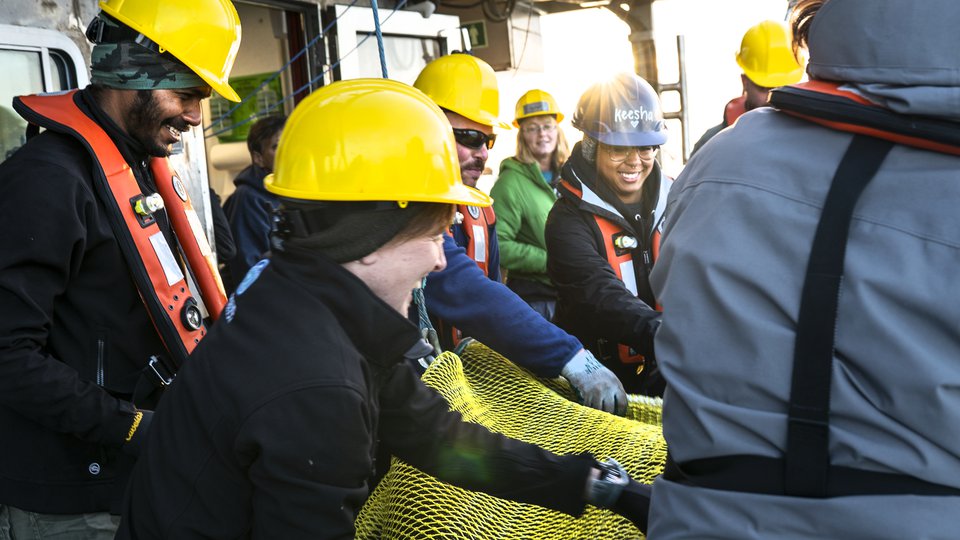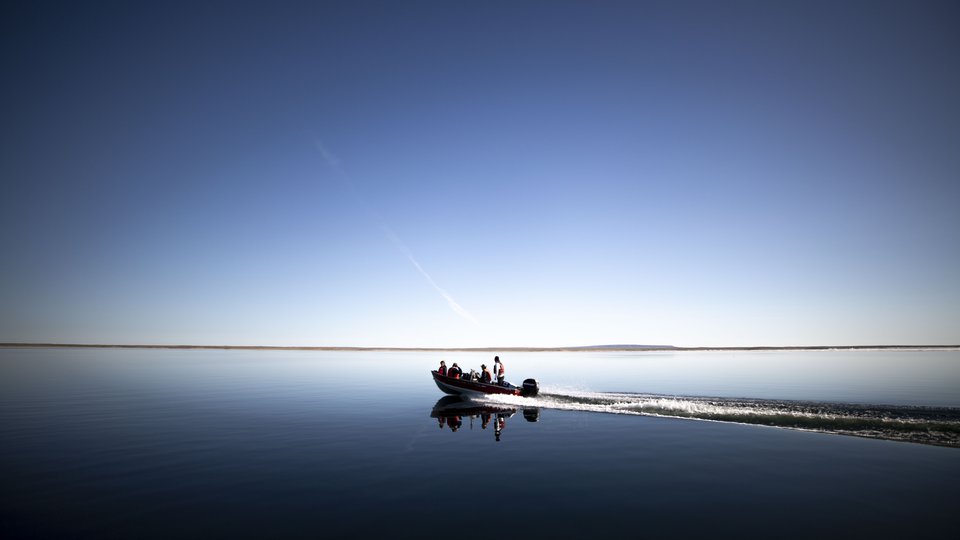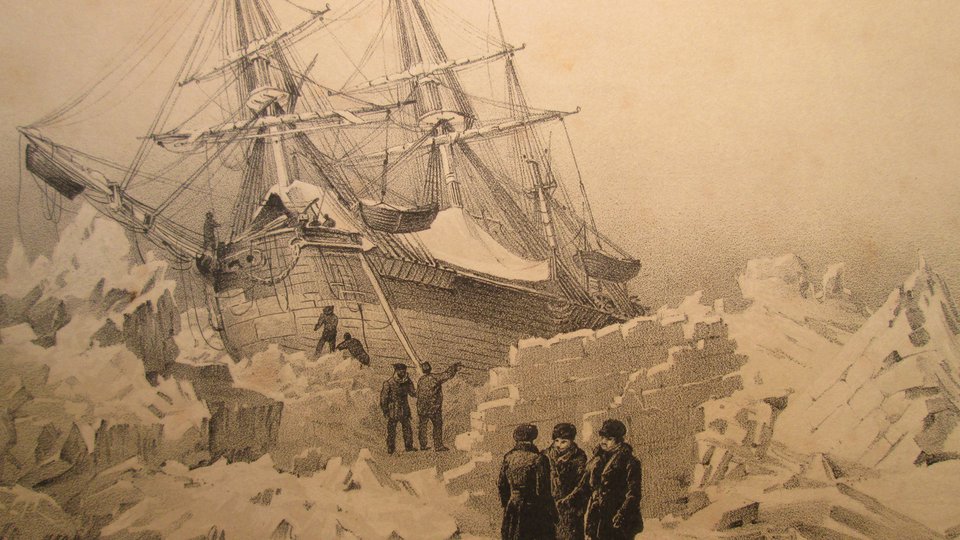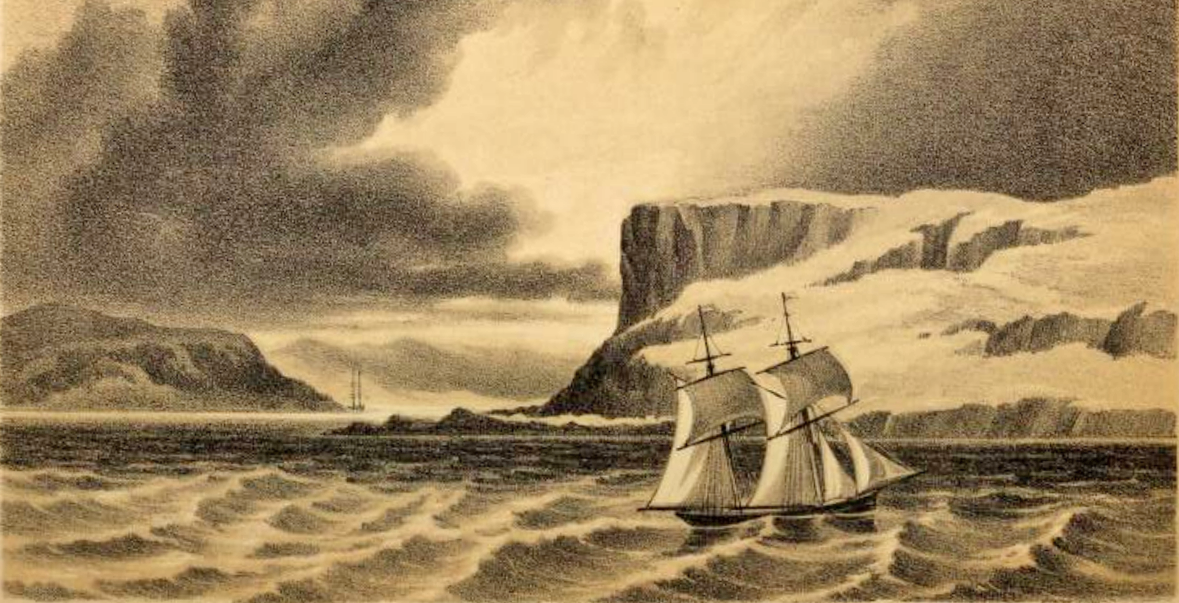
In 2014 and 2016, Sir John Franklin’s ships, the Erebus, meaning the gates of hell, and the Terror were found off King William Island in Nunavut. These discoveries were due to Inuit Knowledge and their oral history and innovation on the part of the Arctic Research Foundation. In 2014 the Harper government hailed the first discovery as Canada’s historic achievement. What are the facts? Both ships were still owned by the British government, and not Canada, since they were lost in 1848, or thereabouts. At the time Canada was still a colony and not a nation. Canada did not “own” the Franklin’s ships or the Arctic in 1848, and perhaps not even in 1880. Only recently (in 1997, then re-negotiated and updated in 2018), has there been an agreement between three governments of Nunavut, the United Kingdom, and Canada to sort the various issues out.
The Canadian content of this British Imperial adventure of colonization in the Arctic has been left out until recently. Only one Canadian-born person, William Kennedy, a Cree/Metis, searched for Franklin during all of those years immediately following the expedition’s loss in 1848. He wrote a Short Narrative about his search which was published in England in 1853. It has never been republished (although it was reprinted in the USA and England) nor has a scholarly edition appeared in spite of the plethora of interest in Canada of the fate of Franklin. Some commentators have even questioned whether Kennedy, as an Indigenous person, was even literate or educated. From 1851 to 1852, Kennedy and his crew in the two-masted schooner the Prince Albert wintered over in the on Somerset and survived without any loss of life. In doing so, he covered more 1,000 miles overland on Somerset and Prince of Wales Islands. The reason for this successful search (although Kennedy did not find Franklin or his ships) was Indigenous Knowledge, or as Kennedy phrased it in his 1853 Narrative, his “Arctic Prescription”. However, I believe that Kennedy knew before he set sail in the Prince Albert where the ships of the Franklin expedition were located. He had at his disposal the advantages of Cree spirituality, Indigenous Knowledge, and the lived experiences of the North. Kennedy did not find the ships in because of the sheer natural power of the North. Simply put, Kennedy could not search southward from the Bellot Strait (named after his second in command) because an Arctic gale prevented him. Alternatively, he decided to explore west and northward to determine and report on where Franklin and his crew were not.
Kennedy understood the profound significance of Place in Canada. The search for Sir John Franklin has been termed the greatest tragedy of British exploration and imperialism in the 19th century. This expedition did not understand the Place in which they found themselves. Kennedy had some of that Indigenous Knowledge and what he lacked, he learned, in that Arctic Place from the Inuit. He led a successful expedition, as an “Arctic College”, in his Search for Franklin from 1851 to 1852. Yet this event and its written Narrative have usually been overlooked in Canada's history. Why has this occurred? Perhaps an answer to this story can be found in the intersection of Indigenous knowledges, oral traditions, and the written record to use Kennedy's own term - “Arctic Prescription”.
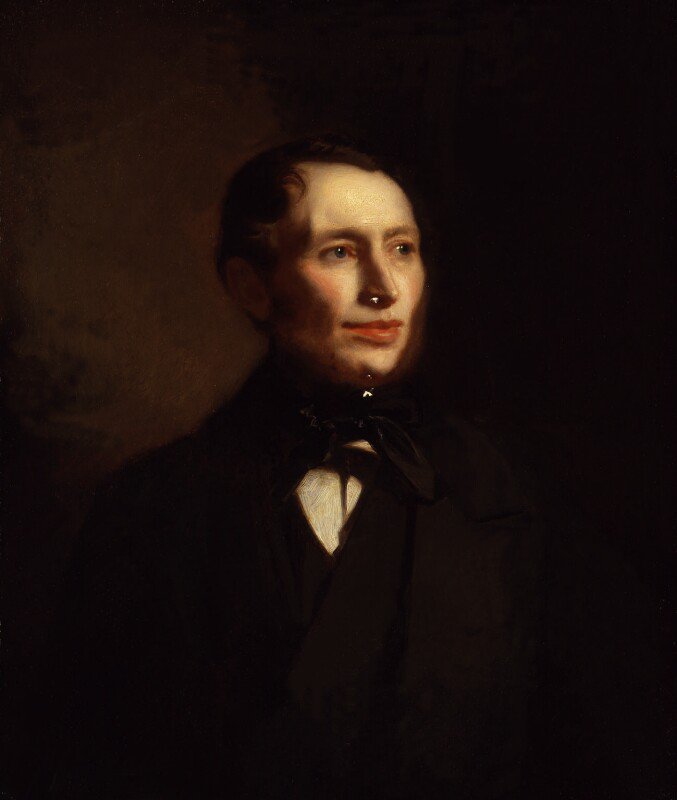
A portrait of William Kennedy painted by Stephen Pearce. Born in Saskatchewan and educated in Scotland, Kennedy returned to Canada to work for the Hudson Bay Company for eight years. In 1851, Kennedy led an expedition, privately financed by Lady Franklin, in search of her husband, Sir John Franklin. At Batty Bay he left the ship, Prince Albert, and travelled for 97 days, covering 1100 miles with dogs and sledges. Kennedy returned to Aberdeen at the end of 1852 and, although he was unsuccessful in his search for Franklin and his crew, he found new routes to crossing the Arctic and made precise charts of the whole area. In 1853 Kennedy published his experiences in A short narrative of the second voyage of the Prince Albert, in search of Sir John Franklin. Image courtesy of the National Portrait Gallery.
While I was attempting to write this paper as part of a longstanding project writing a scholarly edition of Kennedy’s Short Narrative with Paul-Emile McNab, I was reading Sheila Watt-Cloutier’s memoir entitled The Right to be Cold. Her incredible story of going up in the 1950s in Old Fort Chimo (now part of Nunavik) in the Ungava Peninsula is significant for my study of Kennedy who was there as a Hudson’s Bay Company trader from 1838 to 1846. It was in this place that Kennedy added to his life-long Indigenous Knowledge as a Metis/Cree growing up in Cumberland House from 1814-1832, learning every day from his Cree mother, Mary Bear. Indigenous Knowledge has been defined by Watt-Cloutier fittingly as “Silatuniq” which is the Inuktitut word for wisdom. According to Watt-Cloutier, “much of it is taught through the experiential observation of the hunt. The Arctic is not an easy place to stay alive if one has not mastered the life skills passed down from generation to generation. Mistakes can be fatal. But every challenge teaches a lesson, not only about the techniques of thriving in a cold world but also about developing the character that can be accounted upon to stand up to those challenges. It is the wisdom of our hunters and elders that allowed us not only to live but also to thrive.” It is this wisdom that is passed on from generation to generation as a practical everyday reality. Kennedy learned about the wisdom of the Inuit to stay alive and thrive in Nunavik for eight years (likely something he had learned from his Inuit female partners at Old Fort Chimo), and also to thrive when he spent 1851 to 1852 in his search for Franklin without the loss of any of the lives of his 18 man crew.
The real story here is not about Franklin, his men or his ships, or about the finding of the Erebus and the Terror. It is about Inuit wisdom and knowledge, as well as Inuit sovereignty. It is also fascinating to note that the Arctic Research Foundation used both Indigenous Knowledge and scientific equipment to find the Erebus in 2014 and the Terror in 2016. The Inuit knew their land and they shared that Indigenous knowledge with Kennedy both when he was a Hudson’s Bay Company trader and during his search for the Franklin Expedition.
Until the early 21st century, Inuit knowledge had been all but denied in the search for Franklin. The two exceptions were John Rae, an Orkneyman, and Kennedy. Rae, for his efforts in believing the Inuit, was vilified in a highly racist fashion the British press, including the English writer, Charles Dickens, when he returned from his search. For the most part, Kennedy was simply ignored and so was his Short Narrative. He learned to live in the North from the moment he was born in the bush. From 1825 to 1833 his father, the Orkneyman Alexander Kennedy (Chief Factor HBC, 1781-1832), sent him to receive his formal European education in St. Margaret’s Hope School in the Orkney Islands and would have qualified for a university degree like his brother John Frederick, who graduated with his medical degree from the University of Edinburgh. Far from being deficient in formal education, persons such as Kennedy had a “balanced” view and could “see with two eyes”.
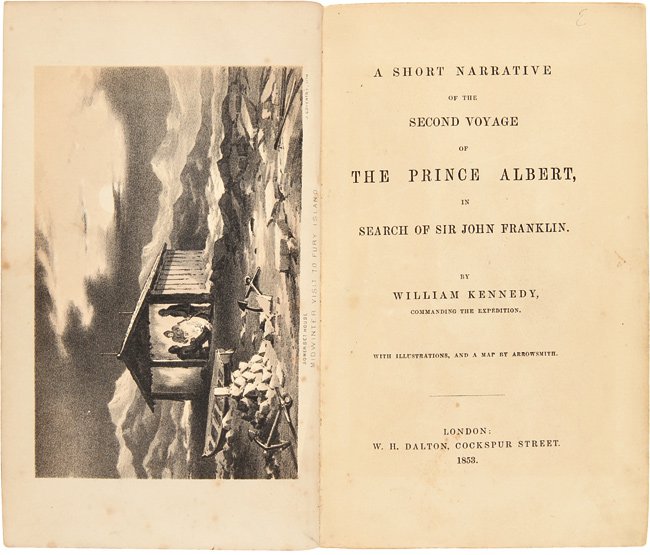
The opening pages of "A Short Narrative of the Second Voyage of the Prince Albert in Search of Sir John Franklin" by William Kennedy.
What then does one make of William Kennedy’s first expedition to search for Sir John Franklin from 1851 to 1852? What does one make of his use of Indigenous Knowledge during his search and also in his Short Narrative? Kennedy realized that Franklin’s search for the Northwest Passage was severely hampered by a lack of Indigenous knowledge. In short, the islands, the waters, and the ice were not on the Admiralty maps. The English ships and their crew had no “wisdom” about the lands, waters, winds and ice that they would encounter. It is not curious or strange that no one survived or that it took 168 years to find the Erebus or the Terror.
Kennedy visited the Admiralty in the winter of 1851 literally demanding that his ship have pemmican to assist in avoiding scurvy on board and that alcohol, except for lighting and cooking, would not be allowed on board the Prince Albert. He knew the dangers of alcohol when consumed in frigid temperatures. This was contrary to the medical European science at the time which it was thought that drinking alcohol made a person “warm”. Kennedy had always operated in the North and knew better. Doubtless, when Kennedy was sent north by Sir George Simpson in 1838 to Fort Chimo in the Ungava peninsula, (without his wife and two children who were residing on the Bear (Grand) River), he became a partner with one, or more, Inuit women for the next eight years. He also learned a great deal from these women about Indigenous knowledge and how to be able to survive in the Arctic. By 1851, Kennedy had been living most of his life in parts of the North. Clearly, he owed much to the lived experiences of Indigenous women in his life.
Kennedy had ordered the Prince Albert to be re-inforced because of the Arctic ice and to be fully provided for an Arctic expedition over water, land and ice:
I had long been of opinion that the search for Sir John Franklin must ultimately resolve itself into a grand series of boat and land journeys, and with this view, after taking on board a supply of raw material, for mocassins, snow-shoos, dog-sledges, &c. to be worked up in the course of the voyage, I caused a “kayack" to be constructed of tin, in imitation of the native Esquimaux canoe; intending, in the event of our progress in the ship, or our own boots, being arrested by any unforeseen circumstances, to adopt the native method of travelling, with which, from many years residence among the Esquimaux of Labrador, I was perfectly familiar. By the liberality of the Admiralty, we were supplied with a ton and a half of excellent pemmican, which proved invaluable in the extensive winter journeys we were afterwards called upon to undertake. No expense was spared in furnishing us with everything else considered necessary for the particular service we were to be engaged upon. Provisions, in full quantity, and in the providing of which no expense had been spared, were placed on board, amply sufficient for two years.
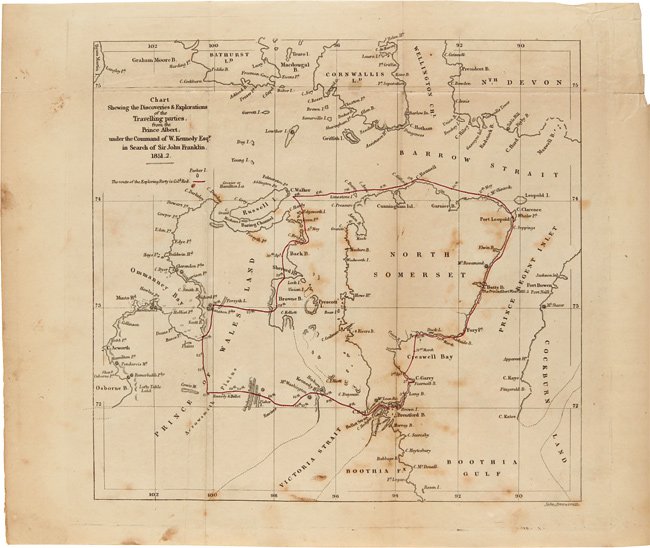
A map from Kennedy's Short Narrative showing the route of his expedition in search of Sir John Franklin.
The tin kayak that he had made, a miniature coast guard cutter, was modelled on the Inuit kayak. The latter made out of tin proved to be a failure. Kennedy also sought out blasting powder from the arsenal at Woolwich which he later used effectively to open up the ice for his ship. He also had on board a miniature portable organ, a gift donated from Prince Albert. He put this musical instrument to good use when the first Inuit came on board. Along with the sledges, however, the first thing he did when he arrived in Greenland was to buy six powerful sled dogs from the Inuit at Upernavik. He knew that the dogs were essential to travel in the Arctic. And they certainly were. The crew was also outfitted with Indigenous clothing to protect themselves from the conditions they would encounter in the Arctic. Lastly, in true Victorian fashion, the post-office of the Prince Albert was outfitted with six British imperial carrier pigeons which turned out to be completely useless.
The crew of 18 was carefully chosen by Kennedy with plenty of experience from another northern land, the Orkneys. It also included the supercargo, John Hepburn, who was an indispensable in Franklin’s overland expedition from 1819 to 1822. As a young person, Kennedy had met both Franklin and Hepburn at Cumberland House. He described Hepburn with the utmost affection: “a name familiar to Arctic voyagers, as the faithful attendant and sharer in the perils and privations of Sir John Franklin’s first adventurous, and in some respects tragic journey through North America, goes out in his old age, as the best tribute he can render, of his affection for his ancient commander”.
The one notable exception was Kennedy’s second in command, Joseph-Rene Bellot, a sub-lieutenant in the French navy, apparently foisted on him by Lady Jane Franklin, with no experience whatsoever in the Arctic. Kennedy found him to be an insufferable fool, especially after Bellot made fun of his Mitchif on board the Prince Albert. Although young, Bellot was an alcoholic. And since Kennedy had no alcohol on board ship, Bellot complained. The latter suffered severe withdrawal symptoms, and made himself miserable to everyone on board after they had left Stromness. He proved to be not only dispensable but also dangerous on the expedition. Kennedy refused to have him accompany his crew on a second expedition. At 27, Bellot died young when he stepped on ice-flow on another Arctic expedition and drowned in 1853.
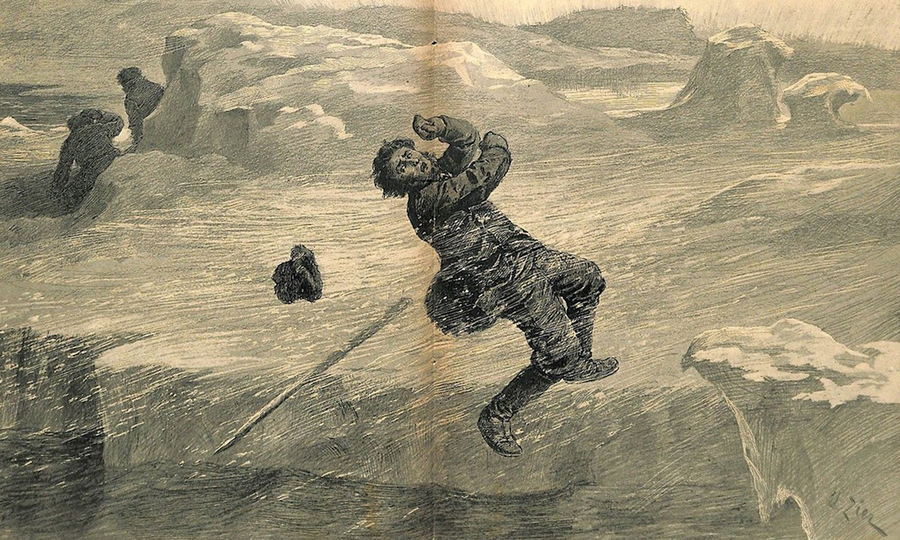
"The Death of Bellot" Image courtesy of Visions of the North.
On his voyage, Kennedy was confronted with pack ice in early July and August, 1851 and his progress in reaching Prince Edward Inlet was delayed. However, he reported on August 26th:
Found ourselves, after a fine run through comparatively open water, off Pond's Bay. We were here for the first and last time during our voyage visited by a small party of four Esquimaux, who reported, having seen some moons' previously two ships proceeding southward, which I have reason to believe could have been no other than the American Squadron, while drifting down Lancaster Sound in the pack.
The four Inuit were allowed on board the Prince Albert because Kennedy understood them. He knew that their Indigenous Knowledge was valuable:
Our Chancellor of the Exchequer, Mr. John Smith, having some acquaintance with the Esquimaux language, contrived to extract some useful information from our visitors, who were, to do them justice, disposed to be friendly communicative to the utmost of their power. One of them, who seemed to have a turn for hydrography, or at any rate had used his eyes to some purpose during his travels, drew with a piece of chalk on the deck, a very correct delineation of the Inlet, leading out of Pond's Bay as far as Navy Board Inlet, and again of Admiralty Inlet for a considerable distance inland.
The Inuit knew their Territory and Kennedy accepted that knowledge. Kennedy then tried European music by bringing out the portable organ and playing it for the Inuit. He recorded the result:
Having extracted what we could from them in the shape of news, the idea struck some metaphysical mind of our party to try the effect of "music on the savage breast." Accordingly the organ was brought on deck and set going, and its effect, whatever it may be in poetry, was anything but “soothing" upon our visitors. From the first, it was evidently regarded as possessed of some mysterious powers of life and volition, which they acknowledged by dancing and singing around it in the most uproarious manner. One poor fellow was particularly distinguished by the oddity and extravagance of his behaviour. At the first note he was observed to “grin horribly a ghastly smile,"- this was followed by a whoop, and a yell, and a leap in the air; as if he were possessed by a legion of demons; and so he went on leaping, and howling, and using all the frantic gesticulations of a madman, till in mercy to the poor creature's wits, we were forced to stop the organ and his ecstasies together.
It was not known what music the organ was playing. Perhaps he was the first Inuit reviewer of European classical music.
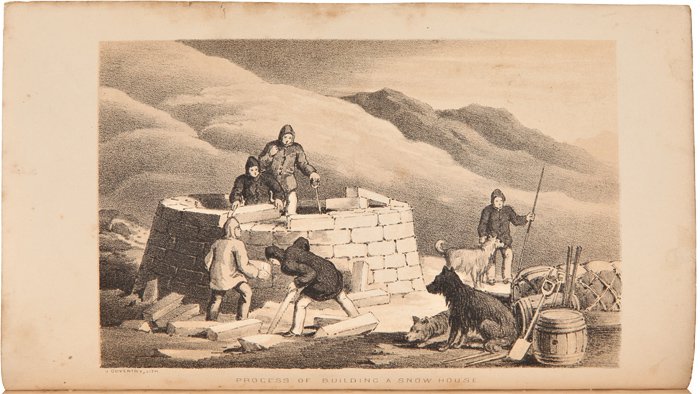
A drawing from William Kennedy's "Short Narrative".
Kennedy observed in his Narrative that, although he had not “discovered” Franklin or his ships because of the Arctic gales that season, he was convinced that the Franklin expedition had gone further south where the ships would eventually be found. In the context of European knowledge, Kennedy wrote that our “chief acquisition in geography: the discovery of a passage from Regent's Inlet to the Victoria Channel of Rae, thereby supplying an important link in establishing the existence of a northwest passage along the northern shores of America”. Kennedy realized that no one had “discovered” the Northwest Passage. As a result of his encounter with the Inuit, he knew that the Inuit knew about it as part of their knowledge about their Place. Much remains to be learned from Inuit Knowledge about these issues. Unfortunately, the pre-eminent Inuit scholar of Nunavut, Louis Kamookak is now longer with us.
Kennedy’s “Arctic Prescription” was based on his teachings of Indigenous Knowledge which he had learned from Indigenous women, the Inuit, and from his own experiential learning. His voice needs to be heard and so do other Inuit voices such as Louis Kamookak and Sheila Watt-Cloutier. His “Arctic College” and his “Arctic Prescription” provided that he and his party was able to survive without loss of life.
Before Kennedy answered Lady Jane Franklin’s call for help to find her husband, he had made himself a persona non grata to the Hudson’s Bay Company (along with his nephew, Alexander Kennedy Isbister) by protesting the Company’s use of alcohol in the fur trade among the Cree and Inuit in the Ungava Peninsula. He then became an entrepreneur at the Saugeen River on Lake Huron from 1847 to 1851 in the fishing industry. After Kennedy’s return from the Arctic, he moved to Toronto and became friends with the Reformers George and Peter Brown of the Toronto Globe. He wrote articles promoting a new concept of Canada in order to end the political deadlock in the Canadas, thereby assisting in the Confederation of Canada in 1867. He moved to St. Andrew’s on the Red River in 1860 with his new wife, the English woman Eleanor Eliza Cripps, after his wife Sarah Stevens had passed away. In the 1860s, he became an entrepreneur with his brother George, running a general store in St. Andrew’s. He championed the building of the northern railway from Winnipeg to Churchill which was built in 1920. In 1865, William became the English language Secretary for Louis Riel’s Provisional Council at Red River. He was a Metis voice for moderation in the first Riel Resistance in 1869-70. Stricken by arthritis in his later years, he was not prominent in the negotiation of the Manitoba Treaty of 1870 or in second Metis resistance in 1885. He passed away in 1890. Despite his many accomplishments, he has remained obscure (except to his Metis family through Seven Generations) and forgotten in Canada’s history.
Suggestions for Further Reading
William Kennedy, A Short Narrative of the Second Voyage of the Prince Albert, in Search of Sir John Franklin. With illustrations, and a map by Arrowsmith. London: W. H. Dalton, Cockspur Street. 1853.
Ken McGoogan, Dead Reckoning, The Untold Story of the Northwest Passage, Toronto: HarperCollinsPublishersLtd, 2017.
David T. McNab, “The Arctic Prescription: Indigenous Knowledge and the Role it played in the Search for Sir John Franklin’s Erebus”, The Aboriginal Business Report, Issue 3, February 2016, 30-2.
McNab, “Métis Voices and Sovereignty: Reflections on Métis Resistance to Imperial Layers of Colonialism in Canada”, Comparative Indigenous Identities, Toward a Hemispheric Approach, M. Bianet Castellanos, Lourdes Gutierrez Najera, and Arturo J. Aldama, (ed), Tucson: University of Arizona Press, 2012, 67-80.
McNab, “Travels of a Metis in North America, and Beyond”, Hemispheric Sovereignties: Indigeneity in the Andes, Mesoamerica, and Canada, edited by Miléna Santoro and Erick Langer, The University of Nebraska Press, 2018, 364-90.
McNab (with Paul-Emile McNab), “‘Arctic Prescription’: Indigenous Knowledge and William Kennedy’s 1853 Narrative in search of Sir John Franklin”, contract with WLU Press, in process, forthcoming, 2020.
Paul Watson, Ice Ghosts, The Epic Hunt for the Lost Franklin Expedition, Toronto: McClelland & Stewart, 2017.
Sheila Watt-Cloutier, The Right to be Cold, One Woman’s Story of Protecting her Culture, the Arctic and the Whole Planet, Toronto: Allen Lane, 2015.
